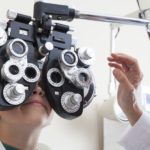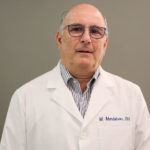
By Moshe Mendelson, OD, FIAO
August 18, 2021
The long-term eye health consequences of myopia are now well known. Yet too often optometrists let young patients walk out the door with a pair of glasses and instructions to the parent to have the child come back for a comprehensive exam in a year to see if their prescription has changed.
The ever-evolving field of myopia management has made this approach obsolete and no longer in the best interest of your patients. Doing so will provide enhanced care while empowering the growth of a strong myopia management niche.
Here is a common mistake made in discussing myopia management with parents followed by a much better way to do it.
The Wrong Conversation to Have
“Jane, Suzie is slightly nearsighted. I prescribed a pair of glasses in order to improve her vision, let’s see her again in one year.”
Unfortunately, this scenario unfolds in many ECP offices across America too often. ECPs give parents a false sense of assurance that once glasses are prescribed for a young myope the child will see perfectly fine, and that appropriate care has been rendered. But has it? Clearly not!
Background Information the OD Needs for the Right Conversation
“There is no evidence of a safe threshold level of myopia for any of the known ocular diseases linked to myopia.”1 Uncontrolled progressive myopia is a disease and if left untreated vision impairment is inevitable. A recent report from the World Health Organization about myopia and high myopia2 indicates that over 32 percent of adult Chinese-American myopes have a significant risk for vision impairments due to myopic macular degeneration. According to a paper published by Bullimore and Brenan3, slowing myopia by one diopter should reduce the likelihood of a patient developing myopic maculopathy by 40 percent.
Some ECPs erroneously consider myopia an inconsequential refractive error, but most are now aware of the potential sight-threatening consequences of myopia. ECPs often elect to wait for myopia to progress, and do not diffuse these potentially alarming consequences early on.
On average, nearsighted children who wear traditional glasses or contact lenses will progress approximately 0.50 to 1.0 diopters per year4. Therefore, ECPs must treat a young child who today is “only” -0.50 diopters nearsighted as someone who will be -6.00 diopters nearsighted 5-10 years from now if they don’t intervene.
The International Myopia Institute (IMI) standard of care guidelines5 calls for educating parents of children at risk for myopia progression about the apparent causes and risk factors of further myopia progression. Additionally, ECPs should introduce parents to the evidence-based myopia intervention tools and options which are available including: specialized contact lenses, pharmaceutical intervention, vision therapy when appropriate and lifestyle changes.
Other Artilcles to Explore
Explaining to Parents the Eye Health Risk Myopia Poses
Unless the parents you are speaking to are optometrists or ophthalmologists, they most likely do not know their child’s myopia calls for anything more than a pair of glasses that will get replaced with a new pair of glasses every time the child’s prescription changes. Explain the eye health consequences of myopia in intelligent, yet easy-to-understand, terms.
Doctor: “Jane, Suzie’s myopia will likely progress as she gets older. It is minor now, however that is likely to change, so that eventually Suzie may even become what we call a ‘high myope.'”
Parent: “So? Can’t we just get her a new pair of glasses whenever she needs it, and then, when she’s old enough, contact lenses?”
Learn More
Doctor: “Yes, we can, but the problem is myopia comes with more than just the inability to see things far away without glasses or contacts on. It comes with the added risk of developing sight-threatening conditions like retina tears/detachment, cataracts, glaucoma and macular degeneration. And of any of those conditions can eventually make a patient functionally impaired.”
Parent [becoming alarmed]: “That’s scary. What do we do?”
Doctor: “Fortunately, we have a treatment now that we call ‘myopia management.’ We have a few different ways to approach this. Let me give you the options, and what I think will work best for Suzie.”
The doctor then proceeds to discuss Ortho-K and other ways of managing myopia, perhaps bringing support staff in at the end to review how fees work in the practice, i.e. one umbrella fee for all myopia management services or whether the practice will charge per visit.
Don’t Forget to Mention Other Less Serious, But Highly Beneficial, Aspects of Myopia Management
I find that discussing the positive aspects of eliminating daytime glasses, such as enhanced self-esteem, confidence and improved sports performance, resonates well with parents.
Doctor: “Jane, the most important reason for us to manage Suzie’s myopia is to safeguard her eye health, but there are many other positive impacts of this treatment.”
Parent: “Really? Like what?”
Doctor: “As a long-time glasses and contact lens wearer yourself–and yourself a high myope–you remember what it was like to have to wear glasses everyday growing up, including what a pain in the neck it was when playing sports, and how often you may not have wanted to wear your glasses?”
Parent [laughing]: “Yes, I remember!”
Doctor: “Well, with myopia management, it is possible that Suzie may not need to wear daytime glasses, and long-term, we may be able to control the progression of her myopia enough that she may never have to wear glasses or contact lenses all the time.”
The parent will quickly see that, whether for the serious long-term eye health benefits, or the immediate cosmetic, comfort and convenience benefits, myopia management is well worth it.
References
1) https://pubmed.ncbi.nlm.nih.gov/22772022/
2) https://www.who.int/blindness/causes/MyopiaReportforWeb.pdf
3) https://pubmed.ncbi.nlm.nih.gov/31116165/
4) Donovan L, Sankaridurg P, Ho A, Naduvilath T, Smith ELIII, Holden BA. Myopia progression rates in urban children wearing single-vision spectacles. Optom Vis Sci. 2012; 89: 27–32
5) https://iovs.arvojournals.org/article.aspx?articleid=2727318
 Moshe Mendelson, OD, FIAO, is a partner with Silicon Valley Eye Physicians. To contact him: m.mendelson@sbcglobal.net
Moshe Mendelson, OD, FIAO, is a partner with Silicon Valley Eye Physicians. To contact him: m.mendelson@sbcglobal.net
Photo credit, top of page: Getty Images





















